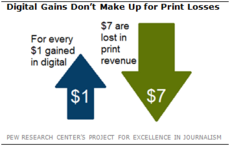Rji-pivot-highlights
From IVP Wiki
Revision as of 19:16, 19 June 2012 by Bill Densmore (talk | contribs)
Contents
- 1 Pre-convening reading -- recommended highlights
- 1.1 1. REVENUE: The Search for a New Business Model: An in-depth look at how newspapers are faring trying to build digital revenue / (March 5, 2012, Pew Research Center)
- 1.2 "The big issue . . . is who gets the right to deliver the time and location sensitive message. it won't be everybody that gets the right to come into my pocket and beep me because I just walked into the mall . . . So how do we, as the newspaper in town, do what we need to do now to make sure a year or two years down the road, we are the ones with permission and a trusted relationship with the consumer."
- 1.3 2. OVERVIEW: "Fungible" -- and looking at the breadth of news industry's challenges (Stijn Debrowere, June 18)
- 1.4 3. TECHNOLOGY: Eight themes on the future of journalism: Google's Gingras and Bharat talk / April 12, 2012, NiemanLab.org
- 1.5 4. CURATION: Are content curators the new 'superheros' of the web? / April 16, 2012 (Steven Rosenbaum, FastCompany)
Pre-convening reading -- recommended highlights
Here are links to pre-convening resources which Randy Picht, Chuck Peters, Bill Densmore and others are among highlights from the general resources and participant comments pages.
1. REVENUE: The Search for a New Business Model: An in-depth look at how newspapers are faring trying to build digital revenue / (March 5, 2012, Pew Research Center)
- In a 27-page report based on an in-depth study of proprietary sales and readership data from 37 U.S. daily newspapers, authors Tom Rosenstiel and Mark Jurkowitz conclude that "digital gains can't make up print loses and papers "are not well positioned to take advantage of ... growth in targeted advertising." The report (download PDF) quotes one executive:
- Why advertisers no longer need media
- Biggest obstacle: The "culture war"
- Industry execs finally talking to each other?
- ‘The future may not be in advertising’
- Focus on functions and values, not tools and procedures
- What about leadership?
- People who figure out the audience will own the future
"The big issue . . . is who gets the right to deliver the time and location sensitive message. it won't be everybody that gets the right to come into my pocket and beep me because I just walked into the mall . . . So how do we, as the newspaper in town, do what we need to do now to make sure a year or two years down the road, we are the ones with permission and a trusted relationship with the consumer."
In an April 24, 2012, discussion at RJI, report authors Rosenstiel and Jurkowitz made these points:
2. OVERVIEW: "Fungible" -- and looking at the breadth of news industry's challenges (Stijn Debrowere, June 18)
- Participant Stijn Debrouwere takes a look at the breadth of the industry's challlenges in this blog post prepared especially for Pivot Point participant consideration, in this post prepared for Pivot Point. He writes: "I've tried to take an opposite but complementary approach in collecting resources, trying to go as broad as possible, because the industry is facing challenges that go from making money, fixing advertising to doing better digital storytelling to figuring out how professional news orgs and communities can work together, and it makes sense to reflect on the sheer breadth of those challenges for a minute."
- A second must read is Stijn's May 4 blog post, "Fungible," where he asserts that journalism is being replaced by niche websites, alternate, socially-mediated content. He offers, at the end, a prescription for "How to Survive."
- Stijn also recommends Pivot Point participant Jonathan Stray's two-year-old post: "Designing journalism to be used".
3. TECHNOLOGY: Eight themes on the future of journalism: Google's Gingras and Bharat talk / April 12, 2012, NiemanLab.org
- In two recent talks, the head of news products at Google Inc. spoke on May 11 at the Nieman Foundation in Cambridge, Mass., and April 26 Madrid, painting a clear vision for how technology can and likely will reinvent journalism by rethinking the "story." Some of Richard Gingras' points: Content is king, less is more, forget the homepage, find the niche. And at Cambridge, he talks about the need for evergreen background pages which provide context for ongoing stories. He calls for constant innovation, and giving reporters (the newsroom's most valuable asset) more tools. Gingras' father was production manager of The Providence Journal. Meanwhile, in Paris, Google News inventor Krishna Bharat urges news organizations to hire "restless agents of change."
- See also: Dave Winer: Curating the public rivers -- the new news-organization task (March 2012, NiemanLab.org)
, who writes: "Therefore, the challenge for news organizations has been, for the last couple of decades, to learn how to incorporate the experience of these users and their new publishing tools, into their product -- the news."
4. CURATION: Are content curators the new 'superheros' of the web? / April 16, 2012 (Steven Rosenbaum, FastCompany)
- The author argues that human curators are the emerging key ingredient in taming information overload, acting as "curators to contexualize and organize information. It means, he says, publishers need to add context, opinion or voice as they curate other sources. He cites Maria Popova's Curators Code. Relevant to the curatorial challenge is Jonathan Stray's recent Nieman Blog post on the challenge of building a hyperpersonalization service.


